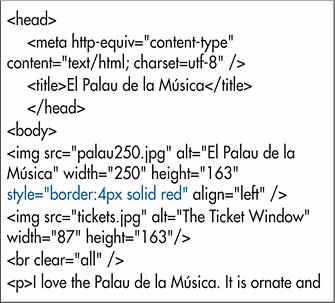Applying Styles Locally
| If you are new to style sheets and would like to experiment a bit before taking the plunge, applying styles locally is an easy, small-scale, and rather safe way to begin. Although it doesn't centralize all your formatting information for easy editing and global updating, it does open the door to the additional formatting that is impossible to create with conventional (X)HTML tags. Figure 8.19. Rules applied locally affect only a single element, in this case, the left img tag. To apply styles locally:
Figure 8.20. Only the left image has a border. To repeat the effect shown in the rest of this chapter, you'd have to add style="border: 4px solid red" to every single img tag individually.
|
EAN: 2147483647
Pages: 340


 Tips
Tips